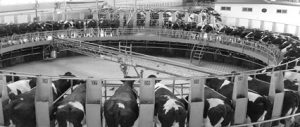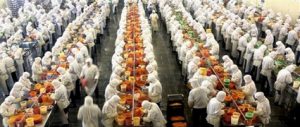China’s dairy industry has been in a precarious state since 2008, the year of the Sanlu milk-powder scandal, when babies across the country were poisoned by melamine-tainted infant formula. This incident revealed to the world the flaws in China’s milk industry, including deep structural problems. This was too big a failure to be passed off as the result of just one brand’s poor quality control.
When it comes to the problematic relationship between agriculture and the food-processing industry in China, this is a case study worthy of analysis.
A history of Chinese milk
Like many of China’s food sectors, the dairy industry has gone through a process of transformation, away from a system characterised by smallholder suppliers and towards modern food production. Milk has not been a part of the Chinese dietary habit for long. Initially it was produced almost exclusively by scattered, local breeders and delivered direct and fresh to the consumer.
Many middle-aged Chinese city-dwellers can still recall going out early in the morning as children and collecting milk from the farm truck as it went on its rounds. Each household would return two empty glass bottles and receive full ones in return. The milk they took home would need to be consumed quickly. A storage and transportation chain that can operate within the time that natural milk stays fresh is like a sort of membership system, through which a local area is supplied via a series of designated stops – a “local production, local consumption” model. In China, this system was shaped by the storage and transport conditions of the time, and received the support of the state-run farms widespread under the planned economy.
The emergence and popularisation of processing techniques including pasteurisation extended the storage time and transportation distances of dairy products. Some regional dairy brands began to quicken their pace of development towards being a modern food industry. In most provinces, breeding farms became bases for provincial dairy brands to be established. These brands began to carry out basic processing and production, handling sales over relatively long distance.
Typical regional brands include Sanyuan in Beijing, Guangming in Shanghai, Wandashan in north-east China and Sanlu in the north. China’s dairy industry developed considerably during this time and, in 2004, per capita milk consumption stood at 18.4 kilograms, marking an average annual increase of 20.64% since 1998. But things changed between 2002 and 2005, when brands like Mengniu and Yili – with substantial financial backing – entered each province and took control of their milk resources. With technical support from packaging firm Tetra Pak, a furious dairy product offensive was waged.
Many regional brands were knocked flat. Even relatively stable supply relationships and price negotiations were challenged. Yili and Mengniu came out on top. Dividing up the milk resources, they quickly established a brand system covering the whole country. This transformed milk from a locally produced product to a modern commodity possible to keep at room temperature for 30 days, easy to store and to transport. By 2008, China’s total milk output was over 37.8 million tonnes, more than five times as much as in 1998.
Chinese people came to accept milk and developed the habit of drinking it. Mengniu and Yili became the leading national brands, while others like Guangming, Sanlu and Wandashan continued their regional focus, at the same time as extending into other regions. Many other local dairy brands produced and sold within the confines of their local provinces. But they were now up against national players, who enjoyed an advantage not just in storage and transportation, but also in price.
China has also made its mark in the global dairy market. In 1949, there were only 1.2 million dairy cows in China. By 2004, there were 10.6 million, and there had been growth rates of 16.4% per year since 1998. By 2011, China had 14.4 million dairy cows.
Centralised milking
During the early development of China’s dairy industry, cows were raised in state-run farms which also distributed milk to consumers. Ten years ago, dairy farmers from these scattered farms started to provide milk to a centralised production industry. Milking stations came into existence, turning the milk production model into one of “decentralised farming, centralised milking”.
On the surface, this was clearly rational: centralisation of goods and equipment would surely guarantee the quality of milk in the primary chain. To quote one dairy farmer: “The milk produced doesn’t come into contact with our hands. It doesn’t even come into contact with the air.” For businesses, having to negotiate and transact with such a large number of dispersed milk farmers also pushes up costs. Milking stations can provide a solution by acting as an intermediate channel in these operations.
The reality is somewhat different.
Many farmers started to raise cows under state initiatives which promoted and encouraged this model. In some places, the state provided favourable loans to these farmers; in others, households which raised dairy cattle received preferential policies for land. When the market is good, one cow can fetch over 10,000 yuan (US$1,600), an enormous financial stretch for a typical household. But once locked into such an investment, it is extremely hard to break free.
For nearly a decade, China’s milk industry developed at an amazing rate. Price and quality became bargaining chips for businesses engaged in fierce competition. In the face of all of this, the dispersed milk farms had no space whatsoever in which to negotiate. They began to depend on the milking stations for their livelihood.
In 1998, Yili started to invest capital in the establishment of independent milking stations with mechanised milking equipment. Each milk station had construction costs of around 500,000 yuan (US$79,000). The following year, Mengniu took the lead in another unprecedented initiative – a milk station established through a social cooperative. Niu Gensheng, founder of the Mengniu Dairy Group, explained the logic: “Someone in the industry wants to set up a milk station and needs 400,000 yuan and I have 40,000 yuan to spare.”
Mengniu took control of milk resources from which the milk station collected a management fee. In only a short time, this model boomed. Many private individual milking stations popped up, as well as milking stations operating under the banners of various organisations, and “opening up channels for dairy farmers to get rich” all over the country. The price at stations upstream and downstream in the industrial chain varied by as much as five jiao per kilogram.
Niu Gensheng described how things operate at the grassroots level: “Inside every village in cow-farming regions, there are always those with money and those with power. When you combine the money with the power, milking stations become a reality.” The “rich and powerful” have placed themselves at the centre of the milk production chain.
Regardless of the size of a business, it must rely on the milk station to obtain its milk. This brings it’s own issues. As long as these milking stations have the right connections, if they have any problem with milk quality all they need to do is give the inspectors a call and quote the batch number, thus ensuring its smooth clearance.
Some businesses have devised measures to prevent these “connections” from disrupting milk quality. Some have specially accredited employees posted permanently within milking stations. Others enforce strict regulations; companies who transport milk change their route once a month and milk-station inspectors rotate on a fortnightly basis.
The ferocious battle for milk resources
Not only did China’s domestic dairy industry develop rapidly during the 1990s, but a large number of international brands, identifying opportunities in the Chinese market, also rushed in, though most withdrew after failed attempts to gain market share. Among a dozen or so such companies were Danone (France), Nestle (Switzerland), Kraft and Dumex (US) and Unilever (UK and the Netherlands). Some of these companies sought out local Chinese businesses as co-investors, others set up independent operations or decided to sell their own products within the Chinese market. But apart from an uplift in business caused by the 2008 baby milk scandal, which strengthened the high-end milk powder market, these companies met with little success.
According to a 2005 report on the Chinese milk industry, the sector’s trade association had already noticed an easing of growth in market consumption by then, and the “dairy processing industry experiencing a decline in profit”. Dairy processing businesses above a certain size saw losses of more than 24% in 2002, 28% in 2003 and 31% in 2004. Businesses selling dairy products saw a drop in the growth rate of total tax and profit payments, which fell by 18% between 2003 and 2004.
Besides factors like the unsuitability of the high‑end route into the Chinese market, an important reason for the decline was the lack of control the foreign capital dairy industry had over milk resources. According to the analysis of Wang Dingmian, chairman of Guangdong’s Dairy Industry Association, the vast majority of multinational companies from the international dairy industry will, on entering China, have invested their energy and capital into processing and sales. They are often unable to gain control of the milk resources, which directly leads to high end-product costs and ultimately removes their market advantage. China’s dairy industry is one where the supply chain is key. It is an industry rooted in local milk resources.
As described above, in the years around 2005, national brands completed a market “sweep”, which shaped the structure for milk distribution and quality control that has existed ever since. The competition over milk resources has been ferocious.
The price war between these businesses still breaks out year after year. Summer is always the high season for milk production but the low season for milk consumption, while winter is the opposite. This has given way to the natural market behaviour of prices dropping in the summer and rising in the winter.
This cycle impacts directly on milk farmers. One farmer said: “At the start of term and during holidays, we can sell all our milk. People from the factories come down and grab it. But when they don’t want it, you could even take it to their factories and they’d still refuse to buy it from you. In a single year, there will be three or four dips like this. The milk from one cow can vary somewhat in quality,” he continued, “depending on the time of year. But it is factories which have the final say on the testing standards. If they say it’s too high then it’s too high and if they say it’s too low, it’s too low.”
When it is that easy for quality control to become the bargaining chips in the battle for milk resources, you can just imagine the consequences. Wang Dingmian explained: “Milk itself contains between 280 and 300 types of nutrient. This makes it impossible to rely on testing methods to control milk quality. Guaranteed quality depends on every link in the whole milk production process – including environment, sanitation, disease control – and if you detect that one batch is not up to standard, all you can do is get rid of the batch. The guiding thought should be geared towards control.”
The direct consequence of each fluctuation in price is that scattered small-scale farms, which are most vulnerable to such risks, are put out of business. According to estimates from officials in Shaanxi province, during the 2007 to 2008 market fluctuations, small-scale farms which had previously accounted for more than 60% of the total market, fell to 30% to 40%. The latest shake-up brought this figure down to around 15% to 20%.
The milk industry’s interests are laid out in a typical triangular structure, with farmers taking 3% to 5% of the profits, the dairy processing industry 20% to 30%, while vendors, packaging and equipment manufacturers take 60% to 70%. The profit margin farmers receive is tiny, while they are being squeezed into smaller and smaller spaces. This compromises the quality of the milk.
This case highlights the reality for China’s food production industry: local small-scale agriculture makes little or no profit, while competition between big brands hits those at the bottom. Between the “small, scattered, chaotic” back-end suppliers and the increasingly industrialised and capitalised front-end businesses, there is a grey area, characterised by the dual operation of a fully modernised market system and a pre-modern, local logic. This is the industry’s battleground.
Xu Nan is managing editor in chinadialogue’s Beijing office.
Homepage image by akiraliml






